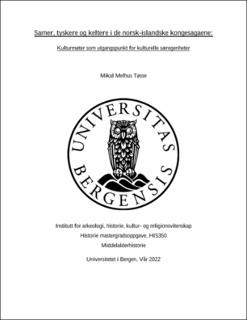Samer, tyskere og keltere i de norsk-islandske kongesagaene: Kulturmøter som utgangspunkt for kulturelle særegenheter
Master thesis
Permanent lenke
https://hdl.handle.net/11250/2998010Utgivelsesdato
2022-05-20Metadata
Vis full innførselSamlinger
- Master theses [240]
Sammendrag
This master’s thesis takes a look at four of the Norwegian-Icelandic kings’ sagas in order to find out in what way instances of cultural contact gives an indication for a cultural distinctiveness regarding the Sami, Germans and Celts. By analysing instances of cultural contact between North Germanic people and these three cultural groups in various contexts, we are able to distinguish certain cultural aspects that the authors of the kings’ sagas find worthy of mentioning. Contact between North Germanic people and the Sami people happens for the most part as a result of them living close to each other and thus interacting with each other. Through this type of contact, the Sami culture is being closely linked to magic and supernatural abilities or occurrences. They are however also portrayed as being highly skilled shipbuilders and hunters. Most instances of cultural contact between North Germanic people and Germans, on the other hand, comes as a result of trade. They are portrayed as highly shrewd merchants and a very specific cultural object that is being linked with them is the cog. The only people that are linked to the usage of this type of ship in the kings’ sagas are the Germans, and because of that it becomes an aspect of German culture. In Heimskringla and Fagrskinna the more important aspect of German culture is their religion, which serves as a contrast to the early North Germanic non-Christians. Instances in the kings’ sagas of cultural contact between North Germanic People and the Celts seems to focus on how the celts wage war. They are highly linked to ambush tactics and are also described as being swift on their feet. In Heimskringla we are also made aware of the fact that the Celts have their own language and their own clothing style. They are however also attributed as being sly and deceitful, which goes to show the often negative attitude the authors of the kings’ sagas have towards the Celts. On the basis of all these findings, a reader of the kings’ sagas can get an understanding of how the culture of the Sami, Germans and Celts are portrayed through the means of cultural contact.
